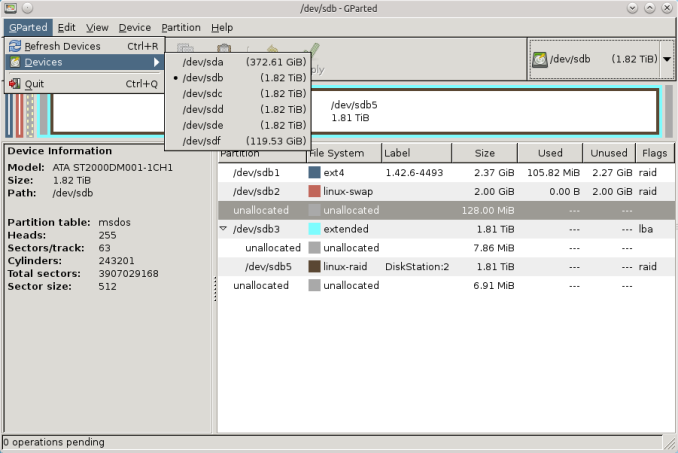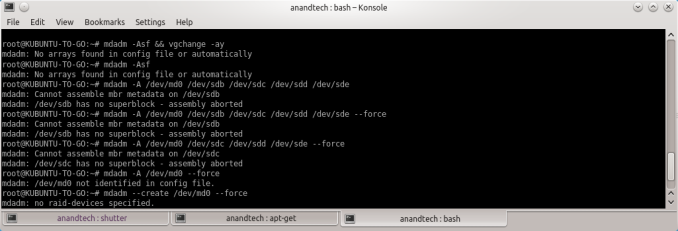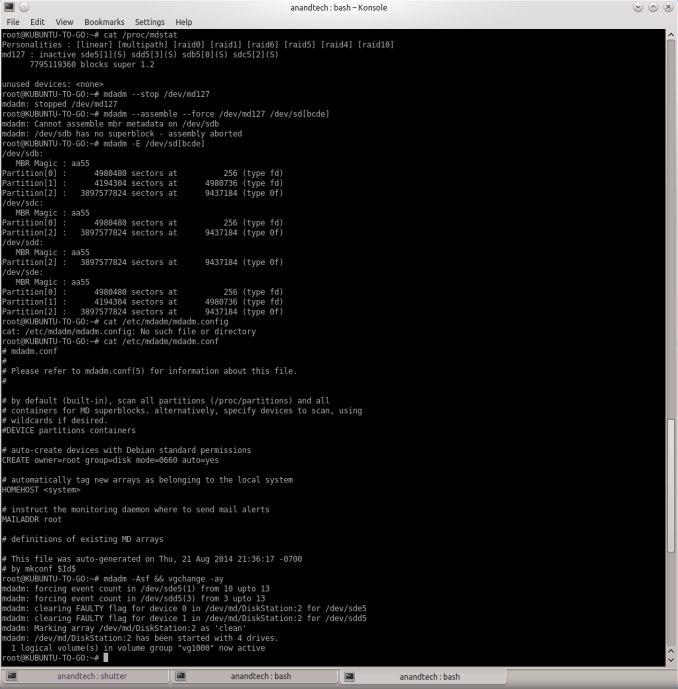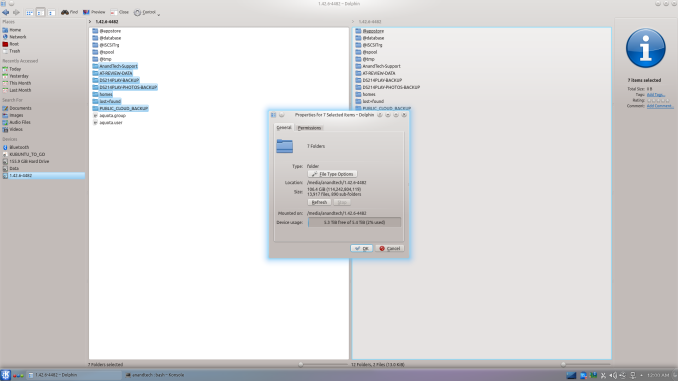Recovering Data from a Failed Synology NAS
by Ganesh T S on August 22, 2014 6:00 AM ESTRecovering the Data
Ubuntu + mdadm
After booting Ubuntu with all the four drives connected, I first used GParted to ensure that all the disks and partitions were being correctly recognized by the OS.
Synology's FAQ presents the ideal scenario where the listed commands work magically to provide the expected results. But, no two cases are really the same. When I tried to follow the FAQ directions, I ended up with a 'No arrays found in config file or automatically' message. No amount of forcing the array assembly helped.
After a bit of reading up the man pages, I decided to look up mdstat and found that a md127 was actually being recognized from the Synology RAID operations. Unfortunately, all the drives had come up with a (S) spare tag. I experimented with some more commands after going through some Ubuntu forum threads.
The trick (in my case) seemed to lie in actually stopping the RAID device with '--stop' prior to executing the forced scan and assemble command suggested by Synology. Once this was done, the RAID volume automatically appeared as a Device in Dolphin (a file explorer program in Ubuntu).
The files could then be viewed and copied over from the volume to another location. As shown above, the ~100 GB of data was safe and sound on the disks. Given the amount of time I had to spend searching online about mdadm, and the difficulties I encountered, I wouldn't be surprised if users short on time / little knowledge of Linux decide to go with a Windows-based solution even if it costs money.
Windows + UFS Explorer
Prior to booting into Windows, I had all the four drives and the LaCie DAS connected to our DAS testbed. The four drives were recognized as having unknown partitions (thanks to most of them being in EXT4 format). However, that was not a problem for UFS Explorer. All the partitions in all the connected drives were recognized correctly and the program even presented the reassembled RAID-5 volume at the very end.
After this, it was a simple process of highlighting the appropriate folders in the right pane and saving it to one of the disks in the DAS.
Fortunately, I had only around 100 GB of data in the DS414j at the time of failure, and I got done with the recovery process less than 10 hours after waking up to the issue.





















55 Comments
View All Comments
Lerianis - Friday, September 5, 2014 - link
Links to the articles supporting that please.YoshoMasaki - Monday, August 25, 2014 - link
Hi there, I was wondering if you would recommend "Windows Server 2012 R2 Essentials with Update x64" as a home server for backups? I can get this for free through Dreamspark (https://www.dreamspark.com/Product/Product.aspx?pr... but I have never used WHS before and I'm a little intimidated by it. Reading "Windows Server 2012 R2 Essentials ... continues to have the requirement that it must be an Active Directory domain controller and that it must be the root of the forest and domain" (Source here: http://winsupersite.com/windows-server-2012/window... makes me think I'm in over my head, but I REALLY get lost when folks here talk Linux/Unix file systems and custom RAID stuff with a half-dozen drives. I'm a Windows guy for 20+ years now so I think I can learn it but I wonder if it'd be worth it. Thanks for your input.YoshoMasaki - Monday, August 25, 2014 - link
Post above ate my links ... please remove the parenthesis from the end or click here:https://www.dreamspark.com/Product/Product.aspx?pr...
http://winsupersite.com/windows-server-2012/window...
fatbong - Monday, August 25, 2014 - link
Completely agree. I wish there was a NAS available which used NTFS and simple disk mirroring. It would make data recovery extremely easy, if the NAS were to suffer hardware failure. I have an aging Buffalo Linkstation Quad, and hardware failure worries me. Is there any NAS out there which uses NTFS ? And no, I dont want to build/buy a server. I want an appliance.Stylex - Thursday, August 28, 2014 - link
Yeah, I migrated from WHS 2003 to Win8 with DriveBender, similar to Drivepool. Love that if it goes sideways all my stuff is NTFS. I don't have time or stress levels to deal with linux command line stuff to get it working again.BD2003 - Friday, August 22, 2014 - link
I recently decided to drop my home NAS (synology ds212j), since I no longer have multiple PCs...and getting that data off was a nightmare. It had a backup drive that was formatted in ext4, since synology didn't support incremental backups to NTFS.Because of the way it stored the incremental backup, it was basically useless for reading directly through an ext driver for windows. I had to completely wipe the backup drive and reformat it in NTFS to make a one time backup, and cross my fingers that I didn't lose a drive during the damn near 24 hour process (thanks to the hyper fragmented NAS drives, barely adequate NAS CPU and USB 2.0.) Then I had to pull the drives, reformat them, and pray the backup worked. Then transfer everything back. This process literally took days.
If it was a windows based box, I could have just pulled the drives, dropped them in the PC and been done with it in 5 minutes, without even rebooting. I probably would have never even dropped the NAS, since I could upgrade it without having to migrate anything.
Basically the entire experience put me off of ever using a Linux based NAS ever again. Between the file system incompatibility and the potential for RAID array failure....it's just not worth it. My data has never felt so unsafe than during that process.
dabotsonline - Friday, August 22, 2014 - link
"In the end, I decided to go with a portable installed system, which, unlike a persistent install, can be upgraded / updated without issues. I used a Corsair Voyager GT USB 3.0 128 GB thumb drive to create a 'Ubuntu-to-go' portable installation in which I installed mdadm and lvm2 manually."Even though it wasn't specified in the Synology FAQ, wouldn't a portable installation of Parted Magic or SystemRescueCd work OK?
Christobevii3 - Friday, August 22, 2014 - link
From my experience with my synology 413j for a while I've learned a few things:First: Turn on the smart disk check to run weekly, otherwise if you never restart the device you won't have a hint of failure coming.
Second: 5TB usb's are cheap, setup a backup task to these.
Third: UPS. Always run a ups. A $50 apc is enough and will hold the device up for a while and allow it to shutdown properly in a power outage.
Last: If you have a disk failure it locks up the device. You will probably be able to detect which disk it is by pulling one at a time. When you get the proper one it will be accessible and you know which disk to replace.
jbm - Friday, August 22, 2014 - link
Very interesting article - have often asked myself what to do if my NAS ever should die a sudden death, because it's a bit old (Thecus 4200) and I probably would neither manage to buy another one nor want to (not because it is bad, just because I'd rather switch to something newer). More articles like this, please!Nogami - Saturday, August 23, 2014 - link
I'd be curious what exactly was the component that died - I've had yet another capacitor failure in the last week which took out an old LGA 775 motherboard (though it happily enabled an upgrade to an i7-4790K).All in all, the vast majority of hardware failures I've had in the last 5 years has been due to capacitor death, usually in power supplies, causing general flakyness, and eventually becoming terminal. I'm curious if that was the case here as well.